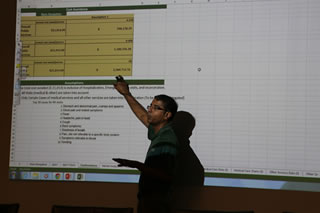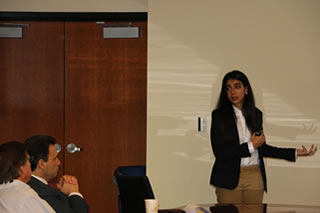News Archive
ISDS graduate student project benefits Bradenton homeless center

ISDS Department Chair Balaji Padmanabhan presents data to Turning Points management
Homeless service centers across the country face ugly stereotypes. People think the work they do is an uphill battle; that centers bring down neighborhood property values; that after treatment and assistance, homeless people will be back on the street. True or not, such stereotypes can do real damage.
The Turning Points homeless services center in Bradenton is one of many that battle such notions. Former Florida Senate President John McKay approached the USF Information Systems Decision Sciences Department at the Muma College of Business to do research on the impact the center had on the community, thinking a valuation of the center's efforts could change perceptions of homelessness relief efforts.
The project that developed could change the conversation not only for Turning Points in Bradenton, but for all types of nonprofits nationwide. Six graduate students in the program spent four months developing a comprehensive model that estimated value for services through four methods that had never been used cooperatively for nonprofits. They looked at market analysis, cost avoidance, quality-adjusted life years, and a hedonic regression model - more on that later.
Presented with this problem by McKay, ISDS Professor and Department Chair Balaji Padmanabhan sought out Raneem Saqr, a PhD student in the department. Padmanabhan knew through her PhD project on designing technology for the visually impaired that she cared about projects that contributed to community. Padmanabhan, instead of creating a straightforward valuation, came up with the design concept for the research - instead of giving Turning Points a number, why not give the organization a model they could work with and use?
"At the end, what we got out of it was a unified valuation framework that can be used by any nonprofit to come up with personalized and informed valuation for each organization - that has never been done before in the literature," Padmanabhan said. "Putting it together and showing how it can be connected was a huge benefit not just for this organization but for nonprofits and academic research in general."

ISDS PhD student Raneem Saqr talks with Dean Moez Limayem and former State Senator John McKay
Saqr took the lead on the months-long project that would take five other graduate students - Ayesha Abdul Majeed, Gaurav Jetley, Francisco Perez Laras, Sridhar Chintha, and Tarun Chataraju - countless volunteer hours to complete, for which they received no payment or grade. They visited the center and spoke with Adell Erozer, the executive director of the center.
Erozer said she was excited for the opportunity to work with the students, as she had seen studies in other communities that provided hard data on the benefits of having housing services available for people in crisis. However, the work the students did exceeded her expectations.
"It was quite astonishing to watch how these students not only grasped the basic tenets of what we were trying to accomplish, but continued to request more and more detailed information and statistics which ultimately led to their development of a new tool for providers of homeless services," she said.
"I feel so proud of the students who worked on this, because it was based on volunteering. They really, really worked hard," Saqr said. "I gave them one task, but they were so motivated that they dug deep."
"It was very nice to see how eager they were to work on something interesting because the opportunity was there," Padmanabhan said. "I think the reason they stuck through is that they could see the value of what they were doing - it was very clear to them that they were getting something out of it."
Back to the research methodology: two of the methods the students used, market analysis and cost avoidance, have been used frequently for nonprofits.
Market analysis looks at the value of services being offered and determines the market rate for that service.
"We did all of that for almost all the services they're offering - medical, dental, human hygiene, even other personal services such as mail," Saqr said.
Cost avoidance estimates the difference in cost to the community of a homeless person being on the streets versus getting services from community based organizations such as Turning Points, from ER visits to using county facilities, and even jail.
The next two methods had been used for businesses, but not traditionally for nonprofits - and never in conjunction with the other three. Quality-adjusted life years examined what homeless individuals could do if their life expectancy was elongated by the services Turning Points provides.
"We were very conservative in our percentages," Saqr said. "We were trying to be hopeful in saying, helping a small percentage of these individuals will help society."
The fourth and final method, the hedonic regression model, tried to measure intangible effect in a neighborhood or a county. This method is mostly used to value the quality of air on real estate - neighborhoods with better air quality will have better home prices, and so forth. Through this analysis, the group found that areas with homeless centers have better home values, contrary to much of the discussion that surrounds building and operating such centers.
Through each of these methods, the students consistently found that homeless service centers such as Turning Points add values to communities they serve.
"Our work is a continuation of other people's work," Saqr said. "There is a strong evidence that investing in these homeless individuals is more cost-effective than leaving them on the streets. However, we were not specifically looking for that result. We said, we're going to collect the data, do the models, and see what we come up with."
"While I knew that Turning Points is providing much needed humanitarian services at a cost that benefits Bradenton and Manatee County, I never envisioned the additional economic benefits revealed by USF's study," said McKay, the former state senator. "Similar organizations and communities throughout America would be wise to take notice."
Moez Limayem, dean of the USF Muma College of Business, said he was so impressed by the students' work that he plans to submit it for recognition awards.
"This project is part of a well-thought out strategy to be a resource for the business community," Limayem said. "We hope to create a site where nonprofits all over the country can use this model to create a valuation for the services they provide. These students are a perfect example of the ways the Muma College of Business is making a difference, not just in the corporate community but in the Tampa Bay community as a whole."
Padmanabhan said he hopes to keep working with the students on the project and submit a paper for publication.
"Homelessness is a major issue in America. It's very worth looking at and worth solving," Saqr said. "No one knew that we would get this much recognition for our work. We were just working."